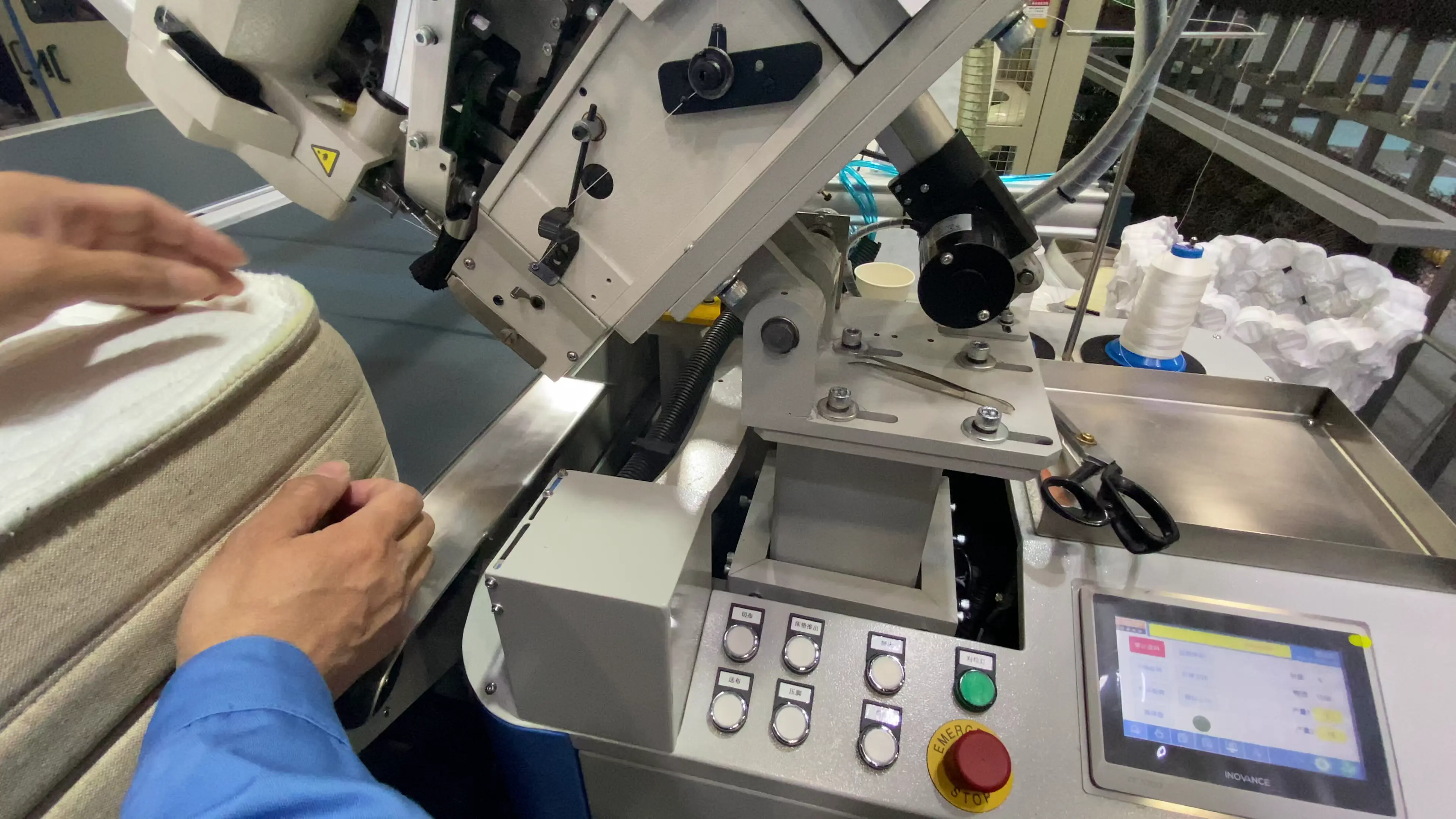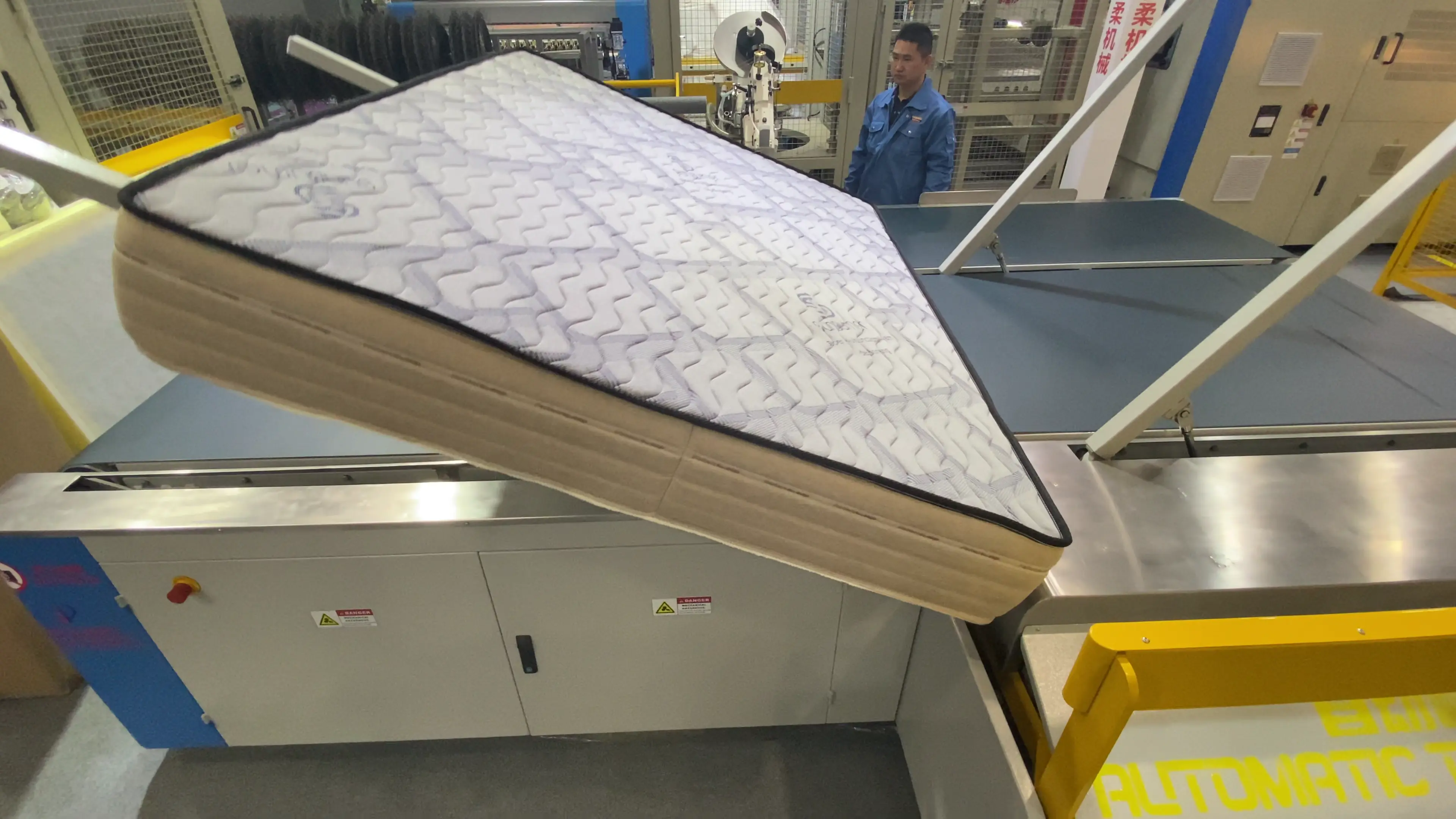A full set of intelligent mattress machinery industry brands
Mattress machines are exported to 150+ countries
Date:2025-06-10
In the fiercely competitive global mattress manufacturing industry, are manufacturers facing challenges such as:
·Manual edge sewing being slow and inconsistent, affecting overall production efficiency?
·Difficulty in recruiting skilled sewing workers and rising labor costs?
·Traditional equipment struggling with complex mattress shapes or high-thickness mattresses?
·Ensuring that each mattress's edge sewing is firm and aesthetically pleasing to meet international quality standards?
Instead of enduring these production hurdles, it's time to explore the benefits of an automatic tape edge machine for mattress production. This article delves into how this mattress machinery transforms traditional methods, covering technical features, operation methods, application cases, and cost comparisons to aid in informed decision-making.

The primary function of edge sewing is to ensure the mattress structure is securely sealed, preventing issues like delamination or material shifting, thereby enhancing stability and longevity. High-quality edge sewing not only improves visual appeal but also conveys a sense of "premium craftsmanship," aiding in higher market positioning and customer satisfaction.
Traditional manual machines heavily rely on the operator's skill. They lack automatic adjustments for mattress height, making sewing quality dependent on manual operation. Novice operators may produce uneven stitches with higher deviation risks.
These machines share configurations with fully automatic ones but require manual adjustments for table height and sewing head inclination. Suitable for small batch productions with varying mattress sizes, they necessitate frequent manual interventions, leading to slightly higher error rates.
Equipped with PLC servo control, touch screen operations, and features like automatic mattress flipping and head adjustments, these machines require minimal human intervention. They deliver consistent, high-quality edge sewing, handling various mattress thicknesses and shapes efficiently.
·Efficiency Leap: One machine can replace 6-10 skilled workers, increasing production speed by over 300% and shortening delivery cycles.
·Consistent Quality: Computer-controlled stitch length and tension ensure uniform, firm, and aesthetically pleasing edge sewing, eliminating human errors.
·Cost Optimization: Reduces reliance on highly skilled labor, saving significant long-term labor costs with a short investment return cycle (6-18 months).
·Complex Process Handling: Easily manages complex edge sewing requirements, including rounded corners and extra-thick mattresses, expanding design possibilities.
·Safety Assurance: Integrated safety features comply with strict safety regulations in regions like Europe, the United States, and Australia.
·Servo Drive Platform: High-precision servo motors move the workbench or sewing head along X/Y/Z axes with ±0.1mm accuracy.
·Automatic Clamping/Vacuum Adsorption: Securely fixes the mattress to prevent shifting during edge sewing.
·Profiling Tracking: Automatically identifies mattress edge contours, guiding the sewing path accurately.
·Industrial-Grade Direct-Drive Servo Motor: Provides stable power at speeds up to 5000 RPM, ensuring high-speed sewing without skips.
·Double/Triple Needle Configuration: Enables multiple parallel stitches in one pass, enhancing efficiency and stitch quality.
·Automatic Thread Trimming: Cuts threads at the end of sewing, reducing manual intervention.

·Industrial PLC + Touch Screen HMI: User-friendly interface for parameter settings, program storage, and production data statistics.
·Multi-Function Programming: Supports manual teaching or CAD file imports for quick program switches.

·Automatic Lubrication: Ensures smooth operation of key components.
·Broken Thread/Needle Detection: Monitors for anomalies, triggering automatic shutdowns to reduce defects.
·Powerful Dust Removal: Maintains cleanliness, preventing dust accumulation.

When selecting an automatic tape edge machine, consider:
·Sewing Head Type: Options include lockstitch, chain stitch, and three-needle five-thread types, each suited for different edge sewing needs.
·Work Efficiency: Look for machines supporting high-speed operations (≥18 meters/minute) and compatibility with assembly lines.
·Compatibility: Ensure adaptability to various mattress types, including thick, soft, roll-wrapped, or custom-sized mattresses.
·Ease of Operation: Prefer intuitive interfaces with features like automatic angle recognition and one-button operations.
·Brand and After-Sales Service: Opt for reputable brands offering comprehensive global support and training.
·United States OEM Factory: Implemented 10 high-speed three-needle automatic tape edge machines, achieving 24-hour production, a 400% capacity increase, and a 65% reduction in labor costs.
·Portugal Custom Workshop: Utilized equipment with 3D sewing capabilities to handle special-shaped and ultra-thick mattresses, becoming a preferred supplier for European high-end hotels.
·Turkish Export Companies: Leveraged the stability and quality of automatic tape edge machines to penetrate demanding markets like Germany and the UK, reducing customer complaints by 90%.
·Brazilian Local Brands: Invested in automatic tape edge equipment to combat rising labor costs, enhancing competitiveness and expanding market share by 20% over two years.
·Uneven or Wrinkled Stitches: May result from mismatched feeding and sewing speeds. Solution: Calibrate the synchronous speed regulation system and check presser foot pressure.
·Unsmooth Corner Stitching: Could be due to errors in corner speed and angle recognition. Solution: Upgrade the servo motor and corner control module.
·Equipment Jamming or Breakage: Often caused by inadequate maintenance. Solution: Regularly maintain the sewing head and replace worn parts.
In the era of automation and intelligence, equipping mattress factories with automatic tape edge machines is not just about increasing production capacity. It's a strategic move to enhance brand competitiveness, meet diverse market demands, and ensure consistent quality. Whether for efficiency, quality, cost savings, or future scalability, automatic tape edge machines are indispensable in modern mattress manufacturing.
A1: Reason: Mismatch between feeding speed and sewing speed; Solution: Calibrate the synchronised speed control system or check the presser foot pressure setting.
A2: There is an error in the recognition of corner speed and angle; Solution: Upgrade the servo motor and corner control module to improve the recognition accuracy.
A3: Reason: untimely maintenance and improper use of sewing machine head; Solution: Regular maintenance, replacement of worn parts, use of high-quality threads.
A4:Professional training is indispensable to ensure that operators are proficient in programming, thread change, needle change, daily parameter adjustment and basic troubleshooting. Systematic training is provided by Lianruo Automatic Seaming Machine.
A5: Strictly implement daily cleaning (remove thread hair and dust), weekly lubrication (specify points and grease according to the manual), and regular professional maintenance (check belt tension, motor, sensors, etc.). Neglecting maintenance is the number one cause of equipment failure!
A6: Absolutely. The output of a standard double-needle automatic hemming machine working continuously for 8 hours usually requires 6-10 skilled sewing labourers to complete, and the quality is more stable.
A7:Touch screen operation, the operator only needs to as start the programme and simple training to get started. Complex programming and maintenance requires more professional technicians, and UNIQUE will provide support.
A8:Professional thick material automatic borders (sewing capacity 30cm-50cm) are equipped with stronger feeding mechanism, longer needles and rotary shuttles, specially designed for this purpose, with excellent results. Be sure to specify your maximum thickness requirements when making your selection.
A9: This depends on the price of the equipment, the labour costs you save, and the benefits of increased production. In areas with high labour costs (e.g. Europe, USA and Australia), the investment is usually paid back in 3-6 months. Accurate calculation needs to be combined with your specific data (current labour cost, output, target enhancement value), please contact us.
A10:Lianruo attaches great importance to customer service experience, for foreign customers, Lianruo provides one year warranty service, wearing parts, easy to wear raw materials and accessories damaged under normal operation are not covered by the warranty. If any parts are damaged under normal operation, Lianrou will exchange the parts for new ones, but since the price of the machine under the contract does not include the shipping cost and tariff of the parts, the customer has to bear the shipping cost and tariff of the corresponding parts. During the warranty period, the customer can ask Lianruo to arrange technicians to repair the machine for him, Lianruo will bear the visa fee of the technicians, and the customer will bear all the travelling and accommodation fee. Summarise: Why every mattress factory should be equipped with automatic edge banding machine?